|
Party Time
The official party season started in splendid form with the welcome return of the Headline Crime Party, this year held in ‘The Heights’, the publishers’ secret penthouse suite looking down (as so many do these days) on the BBC in the heart of London’s West End.
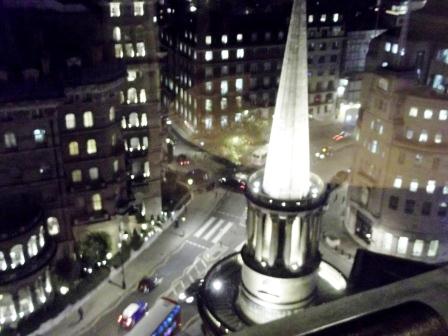
To make sure I was in the right party spirit, I was arrested immediately on arrival, but thankfully only by Headline’s incredibly attractive private security police.
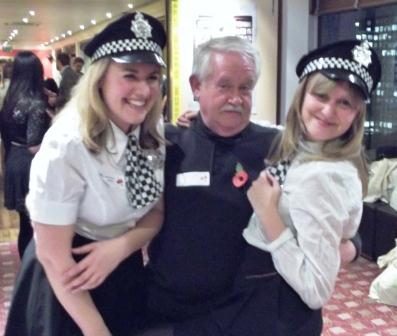
In order to gain release from these officers of publishing law (which took several hours in my case),or at least get to the bar, all crime writers attending were forced to write a few lines of mystery fiction on a conveniently provided typewriter. Here the advantage of my great age came into play, for I was one of the few present who actually recognised what a typewriter was and knew how to use it.

Once my mystery-writing “fine” had been paid, I was free to circulate and mingle with the great and good and Professor Barry Forshaw, who had popped in on his way to his weekly audience at one of the Scandinavian embassies.
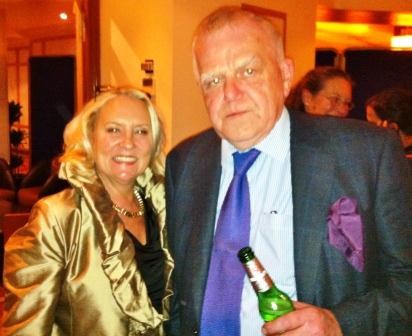
I was particularly pleased to run into my old chums Martina Cole, probably Britain’s most successful female crime writer; Paul Doherty, surely Britain’s most prolific purveyor of historical mysteries; and my fellow boulevardier Marcel Berlins of The Times.
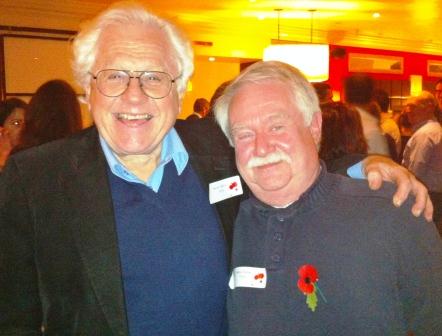
The only drawback to the otherwise utterly splendid evening was being followed mercilessly by what I at first thought to be a photographer from the gutter press, though of course one should be used to such attention from the paparazzi by now. To my amazement the photographer turned out to be none other than millionaire playboy Prince Ali Karim, whom I thought was confined to one of his secret hideouts in order to finish his three-year-long in-depth study of the works of John Blackburn, but had obviously fancied a night off.
The Wisdom of a Mystery Man
Colin Bateman’s anally-retentive hypochondriac ‘Mystery Man’ – surely the most blissfully dreadful hero in crime fiction – reappears in the funniest novel of the year, The Prisoner of Brenda (published by those party people at Headline). Although this is the fourth outing for the misanthropic owner of the Belfast mystery book store No Alibis, I think it is the first time that the author admits up front that there is a real No Alibis bookshop in Belfast, which of course “bears no resemblance” etc. etc., which probably means the lawyers have been in touch. There are also fewer references to branded confectionary this time, which possibly indicates that the sponsorship from Cadbury’s has dried up.
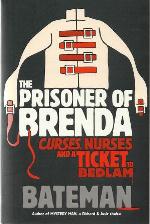
There are, however, loads of great gags and a couple of explosive laugh-out-loud (even if telegraphed a bit) moments and, best of all, the ruminations of the anonymous ‘Mystery Man’ on the state of crime-writing today, for he is, after all, not only a part-time detective but a bookseller.
I will, give two examples to whet the appetite.
Because I knew that the vogue for Scandinavian crime fiction was over, and that my attempts to foist Irish crime fiction on the world were failing miserably, I was now preoccupied with finding what other region of the world might be open to ruthless exploitation.
And when stock-taking in his mystery book shop, he goes into true philosophical mode: There are very few good, new writers out there now. Most crime novels, if you ripped the cover off and gave them to a reader without identifying the author, they wouldn’t be able to tell one writer from the next. There is a template, a style, which 90 per cent of crime-writers adhere to, and they are killing the genre. Crime writing is like a rogue Great White shark. It has to keep moving forward all the time, while taking care to kill plenty of people along the way. There are few stylists, few innovators, and fewer wits.
Thank God there’s still Colin Bateman, and Mystery Man.
The Wisdom of Waldo
I am so pleased that Vintage Books (Random House) have reissued that classic nugget of noir Laura by Vera Caspary, which was originally published and famously filmed in 1943.

This is not only a fine novel and a significant one in the history of crime fiction (for once the word ‘classic’ is not misused), but it features that iconic figure Waldo Lydecker who has, in his later years, served as my factotum and estate manager here at Ripster Hall. In his youth in America, Waldo dabbled in journalism and social commentary, displaying a fine snobbish prose style which instantly endeared him to me.
I have often teased him about his early views on crime and mystery fiction, which co-incidentally are quoted in Laura: “When, during the 1936 (election) campaign, I learned that the President was a devotee of mystery stories, I voted a straight Republican ticket. My prejudices have not been shed. I still consider the conventional mystery story an excess of sound and fury, signifying, far worse than nothing, a barbaric need for violence and revenge in that timid horde known as the reading public.”
I often tease Waldo about that passage and I do believe he is genuinely contrite for having voted Republican…
Still Touring
It was an honour for myself and the Dowager Lady Ripster to welcome my old contubernalis Colin Dexter to the spectacular new First Site Visual Arts Centre in Colchester at the end of November.

Like the Rolling Stones, Colin continues to tour, reminiscing fondly (and modestly) about his famous creation Inspector Morse and the television industry – Inspector Morse, Lewis and now Endeavour – which his novels have inspired, as well as answering, for probably the millionth time, questions about John Thaw.
Although perhaps not quite as spry as he was, Colin’s public performances, even at the age of 82, demonstrate that he has lost not of his dry wit, self-deprecation and instantly-evoked outrage (especially if someone mentions the Daily Mail). In fact, his style as a raconteur is very similar to that of the late, great Gerard Hoffnung (1925-1959).
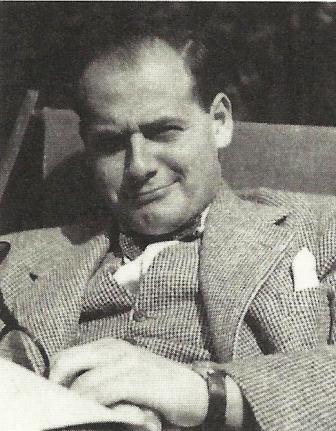
Now I realise that there may be a few readers of this august column who are unaware of Gerard Hoffnung’s career as a musician, composer, cartoonist and humourist. Hopefully they will have the good manners and sense not to admit it in public, unless of course, they are very young, in which case they will. However, the young can now go to something called You Face or Tube Book, or similar, for an example of the great man on top form, recorded at the Oxford Union in 1958 where he tells the famous ‘bricklayer’s lament’.
http://www.youtube.com/watch?v=OOGfg1B3ZMw
That I mention the Hoffnung style in the context of Colin Dexter is no coincidence. As a schoolboy in Stamford, Lincolnshire, a young Mr Dexter was taught German literature by an émigré German Jew, whose family had fled the Nazis in 1939, Gerhard (better known as Gerard) Hoffnung….
Stocking Fillers
Should anyone be stuck (really stuck) for a Christmas gift for an avid reader who takes their crime fiction perhaps a little too seriously, then there is a choice this year of ‘books about the books’ (or in one case the TV series and the books).
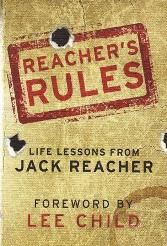 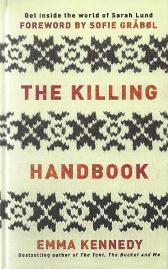
Reacher’s Rules (published by Bantam) comes with a Foreword by Lee Child, whom I believe knows Jack Reacher better than most, and contains much homespun advice. If there is a list of Jack Reacher’s Top Ten favourite Tom Cruise movies, then I missed it, but I was fascinated by a double page spread entitled “Cocked and Locked” until I discovered (rather worryingly) that it seemed to be a page of pin-ups of Reacher’s favourite guns.

For the more sensitive soul facing a lonely Christmas without friends or family, then perhaps The Killing Handbook by Emma Kennedy (published by Orion) is a better bet, for not only does this book give ‘crucial information’ on the world of Sarah Lund - and we simply cannot have too much - but also ‘the plot holes’ in the famous television series. Now this, you might imagine, given that there are more plot holes than in a packet of Polos, would be the key section of the book, but you’d be wrong. By far the most controversial section is the Killing Craft Corner which gives knitting patterns for a Sarah Lund jumper and also a knitted Sarah Lund doll…. And I am not making any of this up.
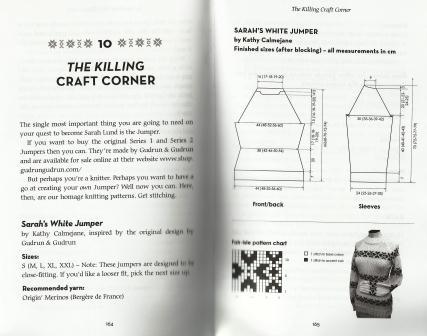
My fear is that by encouraging the chattering classes to take up knitting to pass away the long winter nights when the only other useful social activity is the dinner party game of spotting the plot (hole) similarities between The Killing III and The Bridge (not to mention The Killing and The Killing II), then it can only damage the business of those charming ladies Gudrun & Gudrun of the Faroe Islands, who design and sell the real thing, thus severely damaging the economy of the islands. There is a rumour going round, however, that much of the knitting involved in the jumpers Sarah Lund wears is actually done in Jordan, and not the Faroes, which is surely something a straight-faced (“miserable” to quote Sandi Toskvig) Danish policewoman should investigate. I must add, however, that I was told this by a person who had mistaken me for someone who gave a monkey’s.
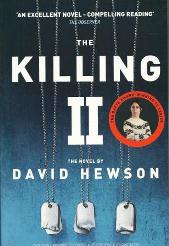
Those who prefer to remain in the real world of crime fiction, however, will only have to wait untilthe first week ofJanuary when Macmillan publishes David Hewson’s novelization of The Killing II. His massive adaptation of the original The Killing received excellent reviews as, I am sure, will his 526-page follow-up.
Clash of the Immortals
Take the world’s most famous detective and pit him against the world’s most famous vampire (at least before the Twilight saga) and what have you got?

Sherlock Holmes v. Dracula of course, by the prolific American writer Loren D. Estleman, and the title more or less says it all. The biggest mystery of all – given the popularity of dear Sherlock and all things vampiric recently – is why this latest reissue by Titan Books is the first time this novel (originally published in 1978) has been in print in the UK in over two decades. Now whilst that’s hardly the wink of a bat’s eyelid for a vampire, it is rather odd given that Holmes is a quintessential British hero and Dracula a quintessential British monster (okay, Anglo-Irish) and both are household names and one could argue that in the cinema and on television, Sherlock and vampires have never been better box office.
The source of the Holmes legend, that first story A Study in Scarlet, celebrated its 125th anniversary last month and no less a national treasure than Stephen Fry launched the celebrations in Portsmouth, where Arthur Conan Doyle lived between 1882 and1890 and discovered that writing was more profitable than attempting to lure patients into his doctor’s surgery.
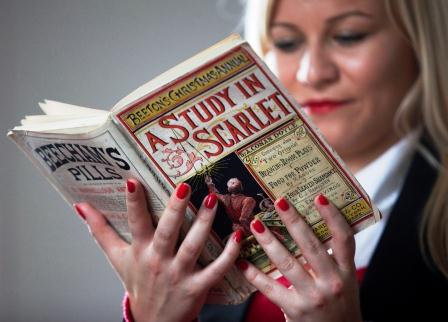
Portsmouth is home to the largest private collection of Conan Doyle books and memorabilia and in a press release by the City Council, Stephen Fry tells me (so it must be true) that Doyle played in goal for Portsmouth Football Club. Presumably he was one of Harry Rednapp’s more inspired loan signings. It is also worth noting that the official Study in Scarlet publicity photograph proves that, like Holmes, Stephen Fry is a master of disguise.
|
|
Proved Right (again)
In seems like only earlier in this column that I labelled Paul Doherty as probably our most prolific writer of history-mysteries and to prove me right, he has just produced another one!
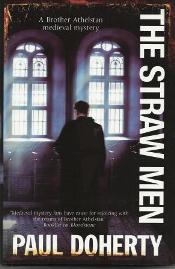
The Straw Men, published by Severn House, is set in 1381 and is the twelfth book in Paul’s famous series featuring his monk detective Brother Athelstan, a series he began back in 1991 under the pen-name Paul Harding.
Do They Know It’s Christmas?
I thought it was a maxim of the modern book trade that the Christmas period these days was reserved for celebrity “autobiographies” and cookery books, with fiction taking very much a back seat. In fact, I have known several crime writers complain of being “Delia-ed” in past years (the catch-all verb for when crime novels are removed from bookshops – rarely to return – to make way for a huge stock intake of the sainted Delia Smith’s seasonal cook book, though the expression could be adapted to the works of the hyper-active Jamie Oliver or those excellent chaps The Hairy Bikers).
It seems odd, then, that new titles by stalwarts – nay, legends – of crime fiction should be released so close to the festive season and could be in danger of being swamped by a deluge of forcemeat stuffing, plum pudding and perfectly cooked sprouts.
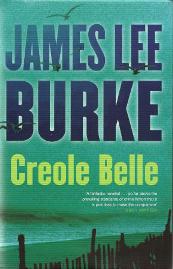
I refer to, and fear for, the new James Lee Burke novel to feature Dave Robicheaux, Creole Belle which is published by Orion in about a week’s time and to a new Joseph Wambaugh title, Nocturne, which is published by Head of Zeus on December 27th, the day after Boxing Day.
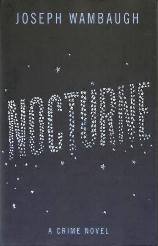
For reasons I really do not understand, Joseph Wambaugh seems to be rather out-of-fashion here in the UK, though I totally agree with the sentiments of Lee Child no less, when he describes Wambaugh’s books as “so good they make me feel like quitting my job and doing something else.” I have particularly enjoyed his recent ‘Hollywood Station’ series (which have at times been hysterically funny) even though their publication in the UK has been somewhat sporadic, and I believe that Nocturne is the fifth in that series, though it will be known in the US under the title Harbor Nocturne as it begins in the port of San Pedro, Los Angeles, where to quote one of the characters “the ocean meets the ghetto”.
Bestsellerdom
In days of yore (whenever they were), a crime fiction editor or publisher would, out of boredom or desperation, take the plunge and read one of the manuscripts from their teetering ‘slush’ pile only to discover the next bestseller had been sitting on their desk for several months.
These days, of course, Health & Safety legislation prevents most publishers from even having a slush pile (or so they claim) and editors looking for new books to publish have to resort to the jolly old interweb and discover titles which are already bestsellers before they are published.
The latest “Number One Bestselling Author” before actually appearing in print, is Kerry Wilkinson, who has written, I believe, 5 crime novels in less than two years and one of them, Think of the Children, is to be a Pan paperback original in February.

The book features his series heroine, DS Jessica Daniel, who made her debut in the self-published 99p e-Book Locked In last year (though currently available on Amazon for 74p), which received 169 5-star reviews, no doubt helping it zoom up the bestseller charts.
As I have pointed out before (and will, no doubt, again), the 1-star customer reviews given to low-price downloads tend to be surprisingly vitriolic – and therefore more interesting. In the case of Locked In, reviews which did not seem to deter download buyers included the comments: “There is only so much mutant English I can handle”; “Failing to engage a proof-reader, let alone an editor, is unforgiveable”; “Predictable and badly written”; “I’d rather spend five hours chewing aluminium foil”; “Totally ridiculous and unrealistic”; “You’d have to be a buffoon not to spot the killer the first time they appear”.
And one of the 1-star reviews certainly did not deter Kerry Wilkinson’s paperback publisher: “I suspect this book would never make it past the desk of a professional literary agent or publisher. Thanks to Amazon for refunding my purchase. It’s not the money. It’s the principle.”
To be fair, reviews of the prolific Mr Wilkinson’s subsequent output, whilst not so numerous, have been much more favourable. One ecstatic reader actually wrote that she “stayed up until 1 a.m.” she was so gripped. Bless.
I wonder if the reason Kindle downloaders get so hot under the collar about spending 99p or less, when paperback buyers spending seven or eight times more seem far less aggressive, could be that they do not get a chance to feel, smell, weigh and examine the product prior to purchase as one can do in a bookshop with a proper book. Do not take my word for it, just look at the number of people in Waterstones who are feeling, smelling, weighing and examining (very closely) a copy of 50 Shades of Grey at any given time.
Happy New Year
I have already been notified by efficient and enthusiastic publishers of more than 100 new crime fiction novels to be published in the first quarter of 2013 and have flagged up some in a previous column but here are a few more selected highlights for January and February.
Peter Bradshaw’s Night of Triumph (from Duckworth) is set in London on VE night, 1945 and is described as “an irresistible caper” which features two rather prominent royal princesses, Elizabeth and Margaret, who famously sneaked out of Buckingham Palace in disguise in order to join in the celebrations. The Palace later issued a statement saying that the episode had passed without incident…but did it?
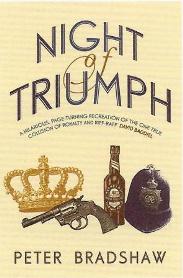
In previous novels, Robert Wilson established his reputation for exotic settings, from West Africa to Portugal. Now with new publisher Orion, his novel Capital Punishment explores if not the most exotic then certainly a dangerous new setting: London. It also, I believe, introduces a new hero, Charlie Boxer – ex-army, ex-police, now working in private security.

I have also been urged by those dedicated publishers Transworld – who never hound, threaten or bribe reviewers or put them to the trouble of attending yet another lavish luncheon – to watch out for the new Belinda Bauer novel Rubbernecker, which they publish under the Bantam imprint at the end of January. I understand that the new book comes highly recommended (“her best yet”) by that bookseller-about-town David Headley, of Goldsboro Books, whose judgement I usually find sound. In view of that, and despite the absence of liquid inducements from the publisher, I will certainly give Rubbernecker a try.

It must be two or three years since I saw the charming Lisa Gardner, when we lunched together with Lady Antonia Fraser. Now with a new publisher, Headline, Ms Gardner goes from strength to strength with her immaculately researched thrillers and I predict great things for Touch and Go when it appears on Valentine's Day in February 2013.
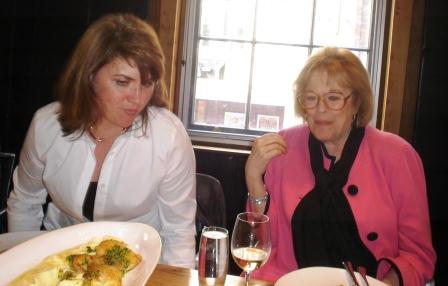
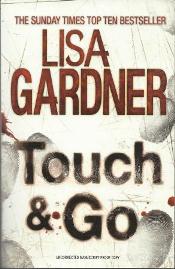
Christmas at Cambridge
For legal reasons I will not be one of the ten distinguished crime writers appearing at a ‘Mystery People’ (?) event at Heffers book shop in Cambridge on Thursday 13th December. The event, a very laudable one, is aimed at customers ‘stocking up for Christmas’ and over a glass or three of wine they get the chance to examine real books and discuss their choices with real authors, which is I believe a service not yet offered by the Amazon Kindle Store. Among the distinguished crime writers attending will be: the elusive Len Tyler, the shy and retiring Alison Bruce and my old chumette Ruth Dudley Edwards, assuming she has recovered from the launch party for her new book, Killing the Emperors the week before.
Now that event, I certainly will be attending.
Graphic Violence
Unlike the cast of The Big Bang Theory I have never knowingly entered a ‘comic book store’. True, there was that misunderstanding on the Tottenham Court Road, but those could not in any way be classed as ‘comics’ and the ladies in question were not actually shop assistants, though they did offer to assist me in several other ways.
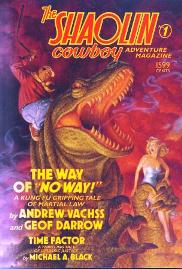
Word reaches me, however, from across the Atlantic that one of the modern masters of noir fiction, Andrew Vachss, is closely involved in the launch of a new magazine called The Shaolin Cowboy Adventure Magazine or S.C.A.M. for short….
Don't Mess with the Romantics
In the last century when I was a member of the Crime Writers’ Association, I learned one valuable lesson. Whilst crime writers thrive on critical reviews of their books, public rudeness, questions about their parentage and are not slow in coming forward on the subject of their advances and sales, it is never wise to mess with members of the Romantic Novelists’ Association.
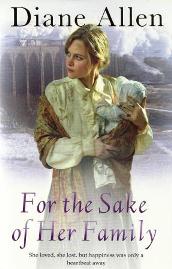
It is therefore with the utmost pleasure that I recommend the debut novel from Diane Allen and publisher Pan, For the Sake of Her Family, a heart-warming saga set in Yorkshire in 1910 with, as far as I (a Yorkshireman) can see, a remarkably accurate rendition of the local dialect. There are also some brilliant descriptive touches (Will Bentham sat in his usual fireside seat, his shoes practically smoking…) which I just know my old mate Reginald Hill would have adored.
Now although For the Sake of Her Family contains numerous dramatic criminal acts, it cannot be classed as a crime novel but it ought to be of interest to the vast majority British crime writers as the author, Diane Allen, is, in her day job, one of the most stalwart supporters of crime fiction, being the General Manager of Magna Large Print Books. There are many CWA members who owe a debt of gratitude (or some of their PLR income) to Diane’s dedication to getting Large Print editions of their work into public libraries over the years.
I Spy, He Spied
It’s been a good year for spy fiction, with splendid new titles from Andrew Williams, Alan Furst, Dan Fesperman, Charles Cumming and Elizabeth Wilson; and the year ends in stunning form with the publication by Duckworth of Robert Littell’s Young Philby.
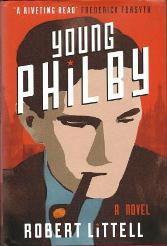
Concentrating on the early career (1933-41) of the famous British ‘traitor’ Kim Philby (was he a double agent or, perhaps a triple agent?), Robert Littell – a fine writer at the worst of times – has produced a technical masterpiece, showing us Philby through the eyes of more than a dozen different observers in England, Europe during the Spanish Civil War and Stalin’s Russia.
Littell knows his stuff when it comes to espionage and spy fiction and his historical dissection of the CIA in The Company is unlikely to be ever surpassed. With Young Philby he turns his eagle eye on the inter-war British spy establishment to great effect, producing some of the best scenes in a very good book. (Note especially the prophetic views of Philby’s father on the Middle East and the ‘mistakes’ of Lawrence of Arabia.) This is a novel rich in characters and situations, masterfully executed without padding (it really is quite short by current standards) or unnecessary historical detail. Moreover, it is unapologetically aimed at a readership which is expected to have a basic grasp of its own history and politics, which is always refreshing.
Shots of the Year
It’s that time again. The annual Shots of the Year awards mean it must be the end of another year; the vote has been cast and the judge’s decision is as final as ever.
Crime Shot of 2012: Standing in Another Man’s Grave – Ian Rankin [Orion].
Thriller Shot of the Year: The Poison Tide – Andrew Williams [John Murray].
First Shot (Debut novel): Seventy Times Seven – John Gordon Sinclair [Faber].
Shot in Translation: 7 Days – Deon Meyer [Hodder].
Comic Shot: The Prisoner of Brenda – Colin Bateman [Headline].
Historical Shot: Young Philby – Robert Littell [Duckworth].
So there you have it; books from six different imprints, two Scotsmen, one Ulsterman, a South African, an American and an Englishman. But, for the second year running and before anyone else points it out, no female crime writers have made the Shots roll of honour. Still, most of the ones I know insist that men are by nature the bigger Shots, though I may have misheard that…
In Memoriam
I understandthat a university in Minnesota, which I believe to be in America, is holding an art show in my honour.

However, I discover that this is a ‘memorial’ exhibition. Is there something I should be told?
Merry Crimble to One and All!
The Ripster.
|